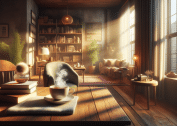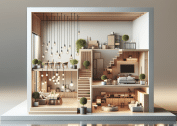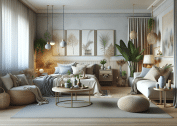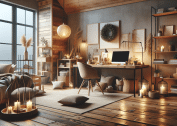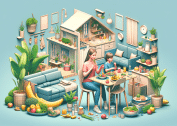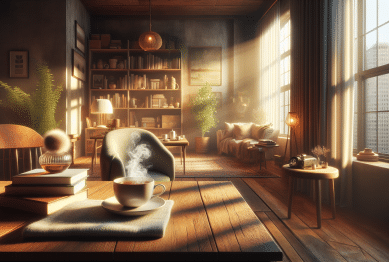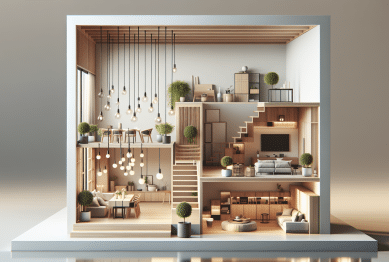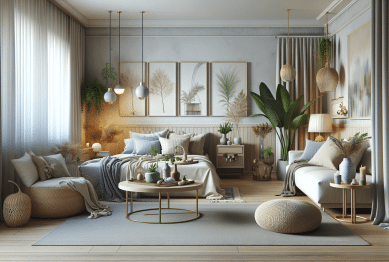Curious how to give your home more charm without a renovation? Discover inspiring home decor upgrades anyone can try. This guide explores ideas from budget-friendly wall art to clever lighting and unique thrift finds. Learn how to transform your space, express yourself, and make every room feel like home.
The Power of Personal Touch in Home Decor
Home decor is more than just furniture arrangement; it reflects individual style and mood. Adding a personal touch can dramatically shift how a room feels. Unique choices, like displaying curated keepsakes or favorite colors, create inviting spaces full of personality. Many find that their well-being improves when surroundings feel meaningful and authentically theirs. Interior design experts often highlight the positive psychological effects tied to personalization in decor (Source: https://www.apa.org/monitor/2017/10/home-sweet-home).
Infusing a room with personality does not require drastic changes or big budgets. Small updates—such as switching throw pillows or layering textured rugs—bring new energy instantly. Even the way books are displayed, or the types of frames on the wall, can reveal so much about a resident’s tastes. The secret? Start small, and let lived-in pieces, family photos, or travel mementos take center stage. This approach helps everyone feel more comfortable, guests included.
Another way to make home decor special is to blend different design influences. Mixing patterns, eras, and cultural motifs can tell the story of a life well-traveled without feeling cluttered. Some people are surprised how a single antique mirror, paired with modern shelving and mixed-metal hardware, makes a statement in an otherwise simple room. This process fosters creative expression and turns a generic space into a welcoming retreat.
Wall Art Ideas for Instant Impact
Wall art lets people showcase creativity and passion in their living space. Whether it’s a bold abstract print, homemade collage, or elegant black-and-white photography, walls become a canvas for expression. Art can shift a room’s mood in ways that fresh paint or textiles cannot. Ideas range from making a gallery wall with family photos to hanging oversized canvas prints above the sofa for a dramatic touch (Source: https://www.smithsonianmag.com/arts-culture/6-tips-to-buying-your-first-painting-22666753/).
Those seeking affordability can create digital downloads or printable quotes for custom frames. Hand-painted accents or DIY macrame hangings inject warmth and texture that store-bought art sometimes lacks. Creating shape and movement by varying frame sizes or incorporating mirrors breaks monotony and enlarges the perceived space. Even simple washi tape outlines or stenciled designs upgrade blank walls with little cost or commitment.
For renters or those hesitant about permanent change, removable wall decals and temporary wallpaper offer playful freedom. This encourages experimentation and keeps decor feeling fresh and seasonal. Swapping out a few prints by theme or color, for example, keeps interest high and the space dynamic. Rotation also means cherished favorites always get time to shine.
Lighting Tricks for Warmth and Style
Lighting can transform both mood and functionality. While overhead fixtures serve a purpose, layering different types of lighting—table lamps, string lights, or sconces—brings coziness into sharp focus. Warm white bulbs and dimmable options create soft ambiance for evenings, while bright daylight bulbs energize mornings. Even a simple floor lamp in a reading nook can change how you use the space (Source: https://www.energy.gov/energysaver/lighting-choices-save-you-money).
Accent lighting isn’t reserved for luxury homes. LED strips under open shelving, fairy lights draped around windows, or battery-powered lanterns enhance texture and visual interest. Strategic placement, such as highlighting a statement plant or art piece, calls attention to favorite corners. This method draws guests’ eyes to what matters and allows for flexible updates as tastes evolve.
More people are choosing smart lighting to customize their environment without professional installation. Smart bulbs, which can shift color temperature or brightness, add playful or relaxing effects depending on mood. Controlled by a phone or voice assistant, these solutions boost convenience and let design adapt for gatherings, movie nights, or quiet evenings at home.
Integrating Plants and Nature Indoors
Houseplants enrich home decor by providing color, texture, and health benefits. Trailing vines on shelves, bold fiddle-leaf figs in corners, or mini cacti on a desk each serve as living art. Research points to plants reducing indoor toxins and supporting mental well-being, making them popular in modern interior design (Source: https://www.ncbi.nlm.nih.gov/pmc/articles/PMC4419447/).
Natural decor doesn’t end with houseplants. Dried flowers in vases, wood accents, and natural fiber baskets introduce warmth and richness. Bringing elements from local nature—like stones, shells, or driftwood—personalizes spaces and connects interiors with the outdoor world. These additions foster calm and balance, especially when combined with sustainable, eco-conscious materials.
Caring for plants brings routine and mindfulness. Many people find watering and pruning comforting after a busy day, and watching new growth is rewarding. Arranging pots by windows or using tiered plant stands showcases collections beautifully. Those short on natural light can opt for hardy varieties or realistic faux foliage for year-round greenery without maintenance.
Reimagining Furniture and Storage
Furniture changes, even subtle ones, refresh rooms with minimal investment. Rearranging layouts to open up walkways can make a home feel renewed. Strategic furniture placement encourages socialization or creates cozy reading nooks. Adding or swapping out accent chairs, colorful poufs, or thrifted side tables shows how flexible design can shape mood and function (Source: https://www.architecturaldigest.com/story/how-to-arrange-furniture).
Creative storage solves daily clutter while contributing to decor. Built-in shelves, multi-purpose ottomans, or decorative boxes invite organization. Showing off books, ceramics, or baskets on open shelving doubles as stylish display. Minimalists may prefer hidden storage to preserve open, serene rooms, while collectors use vertical solutions to make favorite items pop.
Upcycling—like repainting old dressers or adding new knobs to cabinets—is another way to transform furniture with personality. DIY projects allow for experimentation with bold colors or stencils. This customization often builds connection to a space, as each project holds meaning. It’s a sustainable habit too, diverting usable pieces from landfill.
Curating Accessories for a Cohesive Look
Accessories tie the entire look together. Thoughtful curation of throws, pillows, vases, and candles brings warmth to even simple arrangements. The key to a cohesive space is repetition—echoing colors, patterns, or materials throughout a room. This visual thread grounds eclectic mixes and supports tranquility (Source: https://www.housebeautiful.com/room-decorating/living-family-rooms/a2332/decorating-tips-living-room/).
Rotating accessories by season or mood is a low-commitment way to refresh style. Layering different textures—soft wool in winter, airy linen in summer—keeps interest high and rooms adaptable. Trays can organize smaller objects, while colorful baskets collect clutter. Personalized touches, like a vintage clock or family heirloom, offer easy conversation starters.
Scented candles, fresh flowers, and favorite books create a multisensory experience. These manageable accessories are easy to change or update whenever inspiration strikes. Just a few carefully chosen items bring an ordinary room to life. Ultimately, accessories let everyone share their story, one detail at a time.
References
1. American Psychological Association. (2017). Home, sweet home: How housing influences health and happiness. Retrieved from https://www.apa.org/monitor/2017/10/home-sweet-home
2. Smithsonian Magazine. (n.d.). 6 Tips to Buying Your First Painting. Retrieved from https://www.smithsonianmag.com/arts-culture/6-tips-to-buying-your-first-painting-22666753/
3. U.S. Department of Energy. (n.d.). Lighting Choices to Save You Money. Retrieved from https://www.energy.gov/energysaver/lighting-choices-save-you-money
4. Bringslimark, T., Hartig, T., & Patil, G. (2014). Psychological Benefits of Indoor Plants in the Workplace: A Critical Review. Retrieved from https://www.ncbi.nlm.nih.gov/pmc/articles/PMC4419447/
5. Architectural Digest. (n.d.). How to Arrange Furniture for Maximum Comfort. Retrieved from https://www.architecturaldigest.com/story/how-to-arrange-furniture
6. House Beautiful. (n.d.). 50 Decorating Tips for Every Room. Retrieved from https://www.housebeautiful.com/room-decorating/living-family-rooms/a2332/decorating-tips-living-room/


